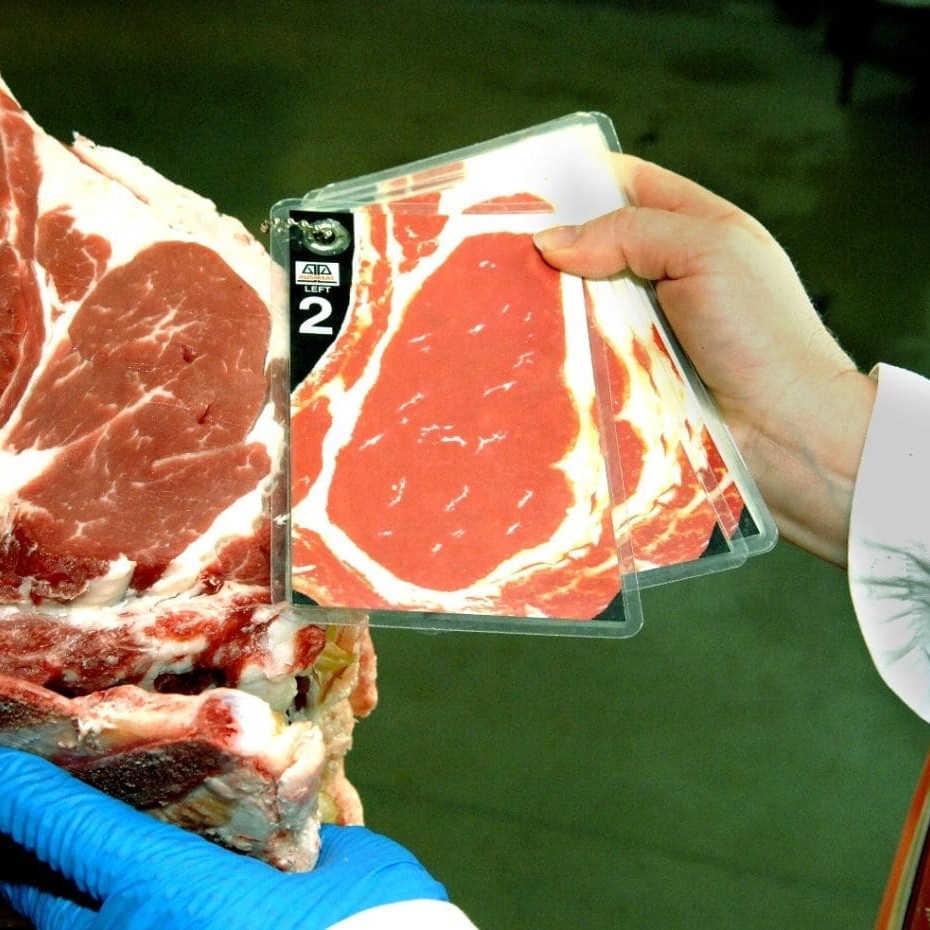 BETTER understanding of the pre-slaughter variables that can impact on Meat Standards Australia grading performance are reflected in annual beef carcase grading compliance rates for MSA released this week.
BETTER understanding of the pre-slaughter variables that can impact on Meat Standards Australia grading performance are reflected in annual beef carcase grading compliance rates for MSA released this week.
Across Australia, beef compliance for the 2012-13 year averaged 93.9 percent of all eligible cattle presented.
While that represented a slight decline from a record-high figure of 94.3pc recorded in each of the two previous years, the overall longer-term trend since MSA started 12 years ago is upwards.
Seasonal conditions are likely to have had some bearing on the latest fiscal year result, with large parts of Eastern Australia experiencing much worse conditions than the two bumper seasons before that.
While overall carcase compliance against MSA criteria remains very high, the slight dip seen last financial year probably also reflects the big influx in new producers accredited for MSA.
As reported in yesterday’s Beef Central summary of MSA’s performance last year (click here to view) there are now more than 30,000 beef and sheepmeat producers accredited for MSA supply, a 28pc rise on year-earlier figures.
That means there are close to 7000 new producers who are still ‘feeling their way’ in terms of the impacts within their own production systems that can have an impact on performance.
MLA managing director Scott Hansen said that far from slowing down the rate of MSA workshop education engagement with MSA suppliers, the need was in fact growing in size. The previous year saw about 4200 new beef and sheepmeat producers join the program.
In Victoria, alone, MSA-accredited producer numbers have grown from just 2098 in 2010-11, to 3025 the following year, and further still to 4766 in the 2012-13 fiscal year just finished.
“For every new producer coming through, it takes some time to determine how best to accurately meet MSA compliance,” MLA’s manager of eating quality R&D, Dr Alex Ball said.
He said the annual MSA grading results showed that there was quite strong seasonal variation in compliance rates, particularly in southern Australia.
“It goes from non-compliance of 3-4pc at better times of year, out to 15-16pc in places during late-September or early-March. That’s why MLA has a major program on at the moment looking at what we can do in southern production systems to try and offset those really tight periods when those big non-compliance increases occur,” Dr Ball said.
Even when non-compliance does increase, there are still producers who are able to maintain very low levels of non-compliance and it is likely that it is the approach in on-farm management that is allowing them to do so.
The seasonal variation was much less evident in Northern Australia, because the northern seasons were less clearly defined.
The southern research work had particular importance, given the big increases noted in MSA producer uptake in southern states like Victoria and NSW.
Big swing to grassfed MSA
Another big factor in MSA compliance performance is the big swing that has been seen towards grassfed finishing systems providing cattle that are eligible for grading.
Traditionally, MSA was very much driven by grainfed cattle, but a lot more MSA supply is now through grassfed channels.
Grassfed went past grainfed as the larger of the two MSA channels about three years ago, and the segment continues to grow under natural and grassfed brand programs. While grassfed MSA grading numbers continue to increase, grainfed numbers are relatively stable.
 “If we are going to see dark cutting issues in non-compliance, it is much more likely to happen in pasturefed cattle than grainfed – although again, there is as much variation within feed types as between them, and lot feeders also need to focus on non-compliance,” Dr Ball said.
“If we are going to see dark cutting issues in non-compliance, it is much more likely to happen in pasturefed cattle than grainfed – although again, there is as much variation within feed types as between them, and lot feeders also need to focus on non-compliance,” Dr Ball said.
“The good thing for southern production systems with the upcoming release of the MSA Index is that, by and large, we’re seeing a continual small, but significant increase in MSA quality coming forward in both the grain and grassfed channels, and that’s only good for the Australian beef industry,” he said.
As more producers started to adapt to MSA, and started to understand where they needed to put their efforts in terms of genetics and management to produce best possible outcomes, those improvements would take a ‘little time’ to come through in results.
The 93.9pc MSA grading compliance figure released for 2012-13 does not include company specs, but refers specifically to MSA specs including pH, meat colour and rib fat depth.
Dr Ball said that similar to previous years, more than 85 percent of non-compliance was due to pH and meat colour issues. The remaining 15pc of non-compliers were mostly rib-fat depth related (minimum 3mm), with other factors explaining only a very small component.
“We normally expect that high level of dark cutting/pH as a factor, because one thing we do know is that for cattle coming through in any process, there will be a proportion more sensitive to stress than others.”
“It’s why MLA and Cattle Council have invested in a big program with Murdoch Uni, SA DPI, Adelaide Uni and DPI to look at whether there are other ways to try to maintain glycogen levels in cattle coming off pasture systems.”
“The holy grain for us would be to have some sort of indicator that would flag an animal on-property that would potentially cut dark after going up the knock box,” he said.
Part of the report that came out after the recent MSA Long-distance Transport project (see Beef Central’s earlier report here) examined potential indicators for this. While most gave no great confidence of delivering a better indicator outcome, one blood component – glucose – gave sufficient indications to deserve closer scrutiny, which was now happening, Dr Ball said.
The industry was continually looking at other issues that could pre-dispose an animal to dark-cutting/pH issues, including temperament and animal handling which can have an impact, on-farm.
“It’s the simple things that producers do on farm. The MSA protocol says animals should not be co-mingled for 30 days prior to despatch, and that mixing of cattle is one of the critical things that can impact on dark cutting. It takes a long time – and a lot of good information –for producers to clearly understand and appreciate that, and how they embed it in their production systems.”
That impact was clearly exposed in the recent MSA long-distance transport work conducted by Rod Polkinghorne and others, where massive variances were seen among cohort groups – ranging from 5pc dark cutting in one group to 83pc in another – clearly due to pre-despatch impacts, rather than the transport times involved.
Dr Ball said one of the ‘really good’ things that had come out of MSA recently was that producers were doing a lot better with the types of cattle, going forward.
In terms of the new MSA index (which has been applied retrospectively across MSA cattle killed over the past five years) there had been a small, but significant improvement in quality and palatability over time.
One of the new reports being built into the new ‘My MSA’ online reporting system will be the ability for producers to benchmark their animals’ performance not only against their own cattle killed previously, but others’ cattle in the same geographic region, or breed types, and perhaps more importantly, against ‘time’.
This online information system will also allow a producer to gauge the impact of a management decision made 12 months ago, seeing what the impact in grading performance has been.
Oss, marbling big factors
Dr Ball said one of the most surprising points that had come out of the MSA Index development work, in both southern and northern production systems, was that the two dominant on-farm factors (apart from HGP use) that drove MSA results, from a compliance perspective, were ossification and marbling.
“That’s been a big learning experience for the producers we are working with to develop the MSA index,” he said.
“Those two really had a dominant impact. Other factors, such as sex and hot carcase weight – and even to a lesser extent, Bos Indicus content – really had a much lower impact on results.”
“In terms of the MSA index, we know that Oss and marbling, relative to hot carcase weight, are between ten and fifteen times more important, and it applies in both northern and southern systems,” he said.
“Even relative to Bos Indicus content, which is eight times as significant as HSCW, oss and marbling are at least 1.5 times more important than Indicus,” he said.
Another fact emerging from the index work is there is surprisingly little difference between steers and heifers in terms of the MSA index, so it is just as important that producers focus on the management of cull heifers.
- The ‘My MSA’ online assessment tool will be part of the MSA optimisation/index program roll-out which will occur in coming months. Stay tuned for more details on Beef Central on these important developments as they occur.
